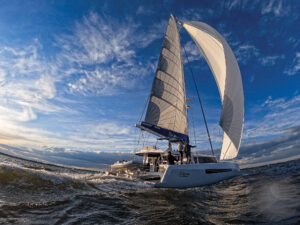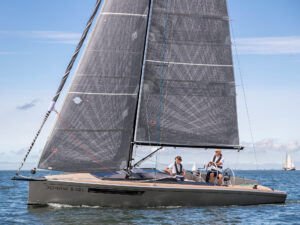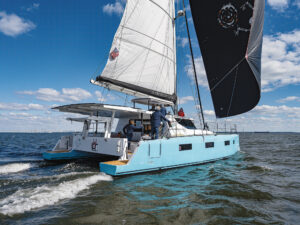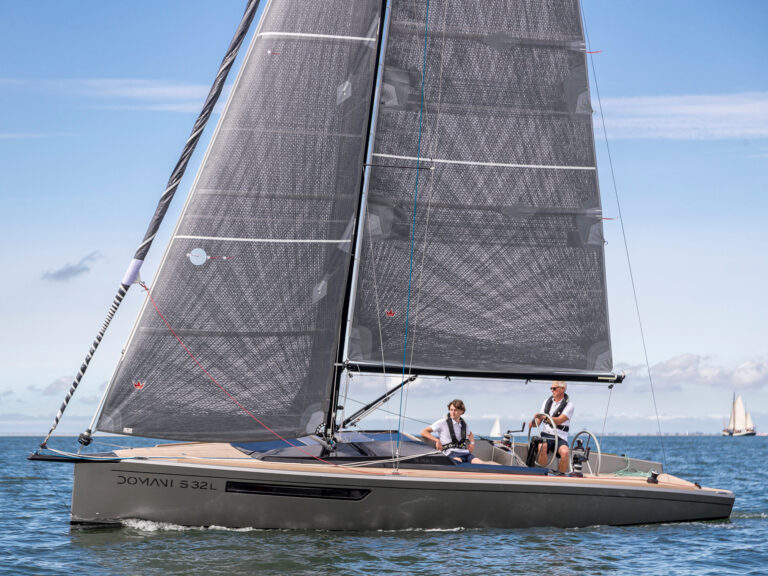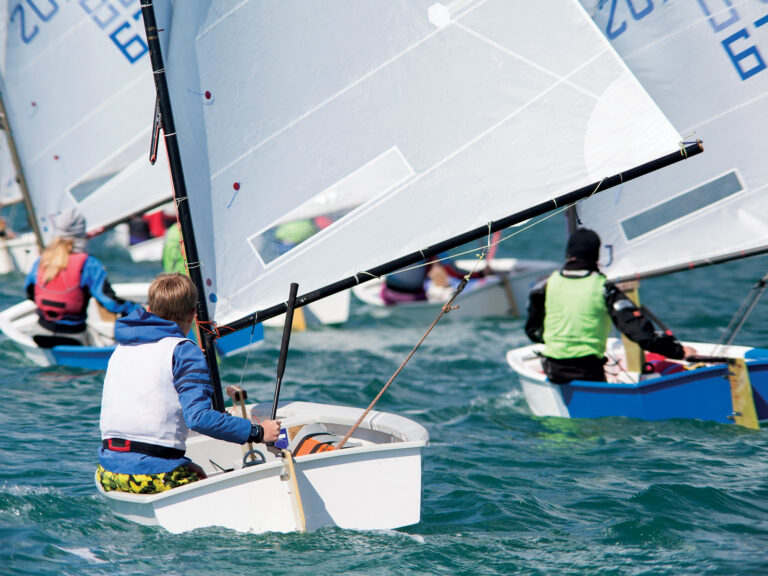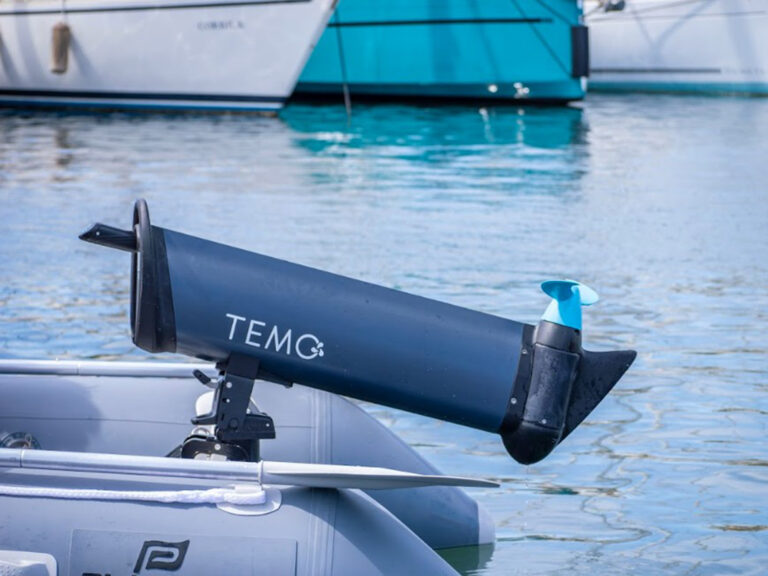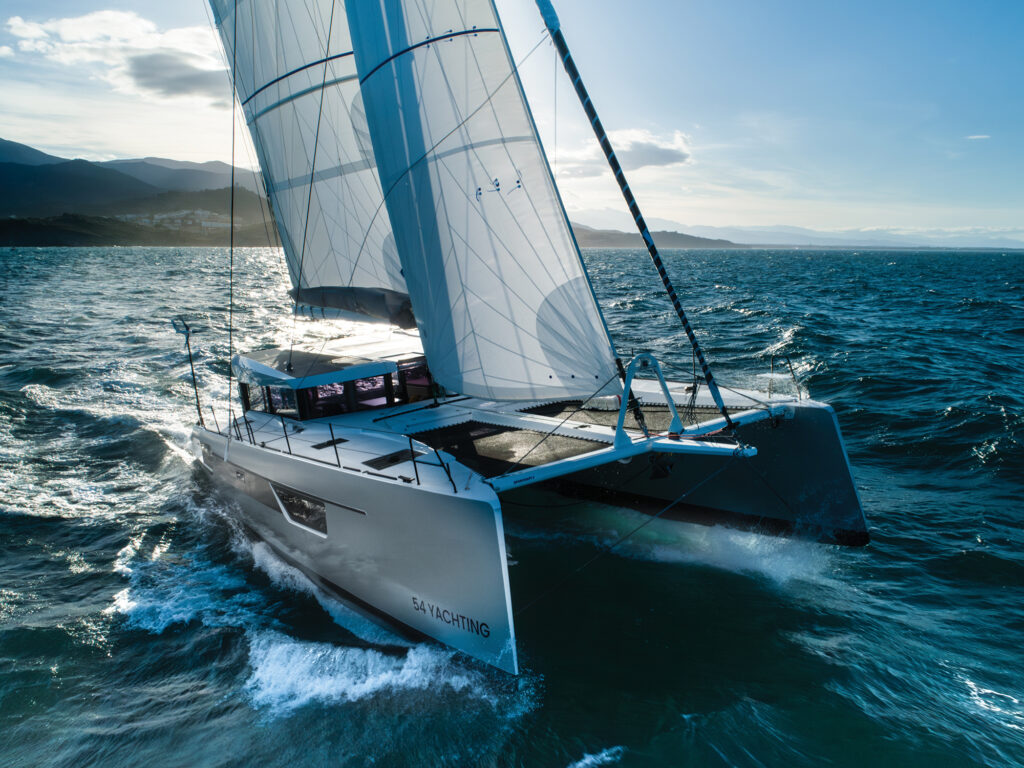
When French businessman and sailor Olivier Kauffmann decided that it was time to buy a multihull and sail around the world with his family, his search for the right boat came up empty. Instead, he founded catamaran company Windelo and opened a shipyard in Canet-en-Roussillon, France, in 2018 with his son, Gautier, now the company’s operations manager. Their goals were to take advantage of the latest building techniques and materials, and to create an eco-friendlier sailboat with a premium on performance.
The Windelo 54 that the Cruising World Boat of the Year jury got to inspect and sail at this past fall’s Annapolis Sailboat Show met those design criteria square-on. The big luxurious cat has a livable and uncommon interior layout. It sails well. And it’s built using composite materials made from recyclable basalt fibers rather than fiberglass, as well as PET foam made from recycled plastic bottles. Adding to its green credentials, the 54 has a hybrid electrical system that relies heavily on carbon-free power sources, such as wind, solar and hydroregeneration, to cover house loads and provide propulsion via two electric motors. But the power system is practical too. Its lithium battery bank is backed up by a diesel generator, providing long-range cruising capability, though company representatives said that it’s rarely needed.
Out sailing on the Chesapeake after the show, the Windelo was well-mannered and quick. Under gennaker, we reached along at 8 knots and better in just 11 knots of true wind. At that speed, the feathering Gori props were spinning and putting power back into the battery bank, which we could monitor on a display screen in the cockpit. And beating upwind, with the self-tacking jib set and the daggerboards down, the 54 was able to sail at close to 35 degrees off the breeze, which is fairly close-winded compared with many other cruising catamarans.
In the end, the judges were impressed enough by all the features that we awarded the Windelo a Special Recognition Award for innovation. Truly, we’d not seen anything quite like this boat before.
Windelo builds about 10 boats a year at its yard on the Mediterranean. Models range from 50 to 55 feet. For design work, the yard uses naval architects Christophe Barreau and Fréderick Neuman, both of whom have experience designing high-end production catamarans for builders such as Catana and Outremer. Hence the slippery hulls and a versatile sail plan that includes a square-top full-batten main along with the two aforementioned headsails.
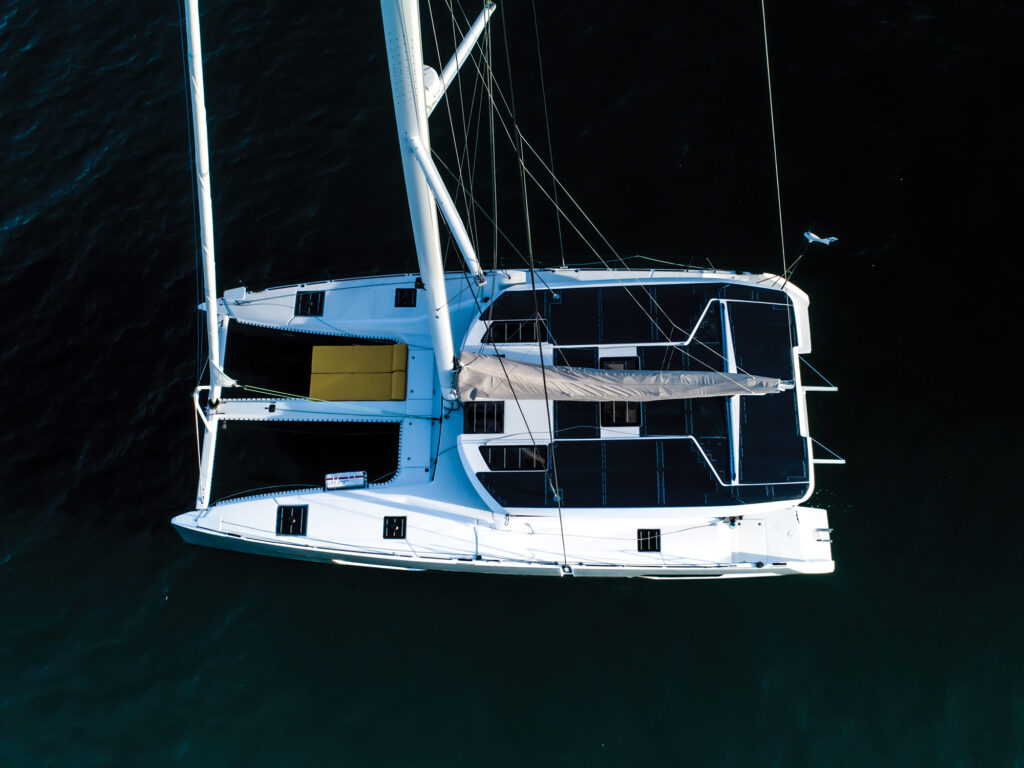
The kitted-out boat we sailed, with a price tag just south of $2 million, was a Yachting model, which has a number of options in terms of woodwork (all certified as being sustainably grown) and upholstery, Incidence sails, and amenities such as a customized hull wrap, a painted aluminum mast and boom, a composite gangway, electric toilets, Corian galley counters, a convection stove and oven…the list goes on. The boat is also available in a more basic Adventure package, with a more limited choice of wood and fabrics, as well as a Sport model that includes Incidence DFi sails (or optional North 3Di sails), a carbon-fiber mast with Kevlar shrouds, oversize daggerboards and rudders, and other performance enhancers.
The standout feature of the 54 is its dual-helm forward cockpit, located indoors at the forward end of the salon. In boisterous conditions, this area can be shut off from the rest of the interior by closing a waterproof sliding door. There are openings with canvas covers forward in the salon to either side of the mast, with steps and clear overhead panels that can be opened for access to the foredeck, and winches on the spar that are used when reefing.
All other sail-control lines are led indoors to three large electric Harken winches between the wheels. The center winch tames the main; the ones to either side are for headsail sheets, and they’re located next to the steering wheels for easy access by the helmsman.
We reached along at 8 knots and better in just 11 knots of true wind. At that speed, the feathering Gori props were spinning and putting power back into the battery bank, which we could monitor on a display screen in the cockpit.
The boat’s anchor windlass is also located inside; chain is led out through a hole to the anchor and anchor roller located under the trampoline on the foredeck. During our anchoring drill (on every boat we test, we lower and raise the anchor to see if things go smoothly), I sensed that it might be difficult in certain conditions to keep track of the direction of the chain when hauling it in, though crew giving hand signals on the foredeck would take care of that problem.
Under sail, I appreciated the twin wheels. It was easy to move between them in order to watch the telltales on the headsails, and visibility forward was excellent. Besides allowing the helmsman to enjoy the company of the crew, the location of the cockpit will also allow the person on watch to step over to the nav station or walk aft to the galley to grab a warm cup of something on a dark, chilly night.
Speaking of the galley, the one on the 54 is terrific. It’s laid out to starboard, in a long U-shape that gives the cook plenty of places to brace when cooking underway. In good weather, windows on either side of the cabin slide open, as do the doors that lead to the aft cockpit, which really opens up the interior to the world outside.
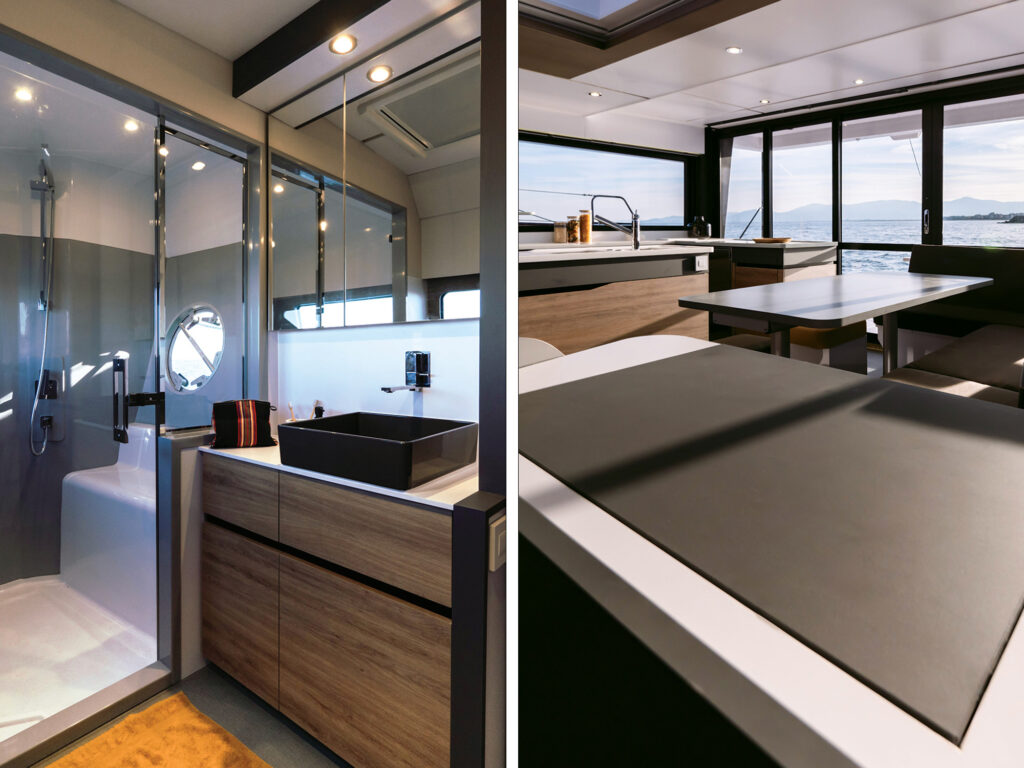
Opposite the galley, the table can be set to accommodate 10 guests. Just outboard of it, there’s a pilot berth—another fine nod to utility and safety. An off-watch crewmember could rest there but be readily available if needed. Forward of it there’s a desk-style nav station with a flat-screen display for charts or to monitor systems, including the battery bank.
The 54’s two hulls can be laid out in a number of ways. The boat we sailed had the owner’s stateroom to port. From the athwartship aft berth, there’s a commanding view of the water through a port in the side of the hull that also curves across the transom. Amidships, there’s a desk/vanity surrounded by lockers; a head and a shower with a bench seat are forward.
Two guest staterooms, each with fore-and-aft bunks, take up the starboard hull, with a head and shower compartment and a washer and dryer between them. Though the hulls are relatively narrow at the waterline, they flare out to provide plenty of living space. Layout options include bunk beds, home office or workshop in the guest staterooms, a skipper’s berth in the forepeak, or four guest staterooms, which would be popular if the boat were to be put into charter.
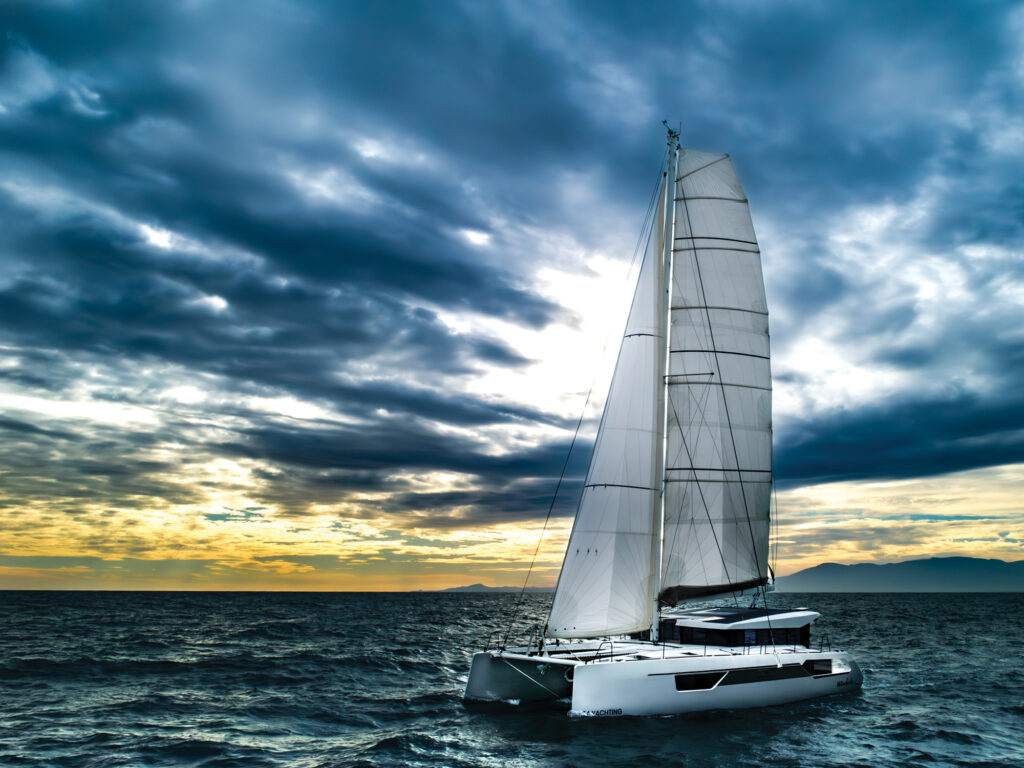
In recent years, many of the more-popular cruising catamarans we’ve encountered during our Boat of the Year trials have tended to have similar features. Not the Windelo. The 54 comes loaded with fresh ideas about how sailors can roam the seas and leave a little less carbon in their wakes.
Mark Pillsbury is a CW editor-at-large and was a 2025 Boat of the Year judge.
Advanced Construction, Cleaner Cruising
In Windelo’s marketing material, the phrase “Ocean Future” is prominently displayed to highlight the company’s intent to build performance multihulls that are more sustainable to own and sail.
To do so, they turned to materials researchers at French school Mines d’Alès to develop a composite sandwich that consists of basalt fibers made from volcanic rock and a foam core made from recycled plastic bottles.
Making fibers from basalt is a process that was pioneered in the United States by Paul Dhe in the 1920s, and was further developed after World War II, primarily for military and aerospace use by the US and the Soviet Union. Today it’s used in a wide variety of applications, from automotive to construction to wind-turbine blades to heat protection.
Basalt fibers are made by melting down naturally occurring volcanic basalt. According to Windelo, no additives are needed in its production, which reduces carbon emissions by a factor of 10 when compared with fiberglass. At the end of its life cycle, it can be remelted in a furnace and rewoven.
The polyethylene terephthalate core material in the boat’s composite-sandwich construction is made from recycled plastic bottles that get crushed into small pieces and are then melted down to create foam. During our visit to the Windelo 54, a canister of PET pellets sat on the salon table and looked like a jar of jelly beans. Company literature reveals that producing the foam creates almost half the carbon dioxide generated when making the PVC foam that is more typically used in boat construction. In high-load areas, PVC is added to the core for greater strength.
More-sustainable building materials are just part of the story, though. By design, the Windelo’s hulls are easily driven, so owners will do more sailing and less motoring. Meanwhile, the builder employs a hybrid-drive system that relies heavily on renewable energy sources, including 5,880 watts’ worth of solar-power panels mounted on the cabin top and Bimini top, wind turbines that can generate 400 watts of power, and hydroregeneration that kicks in anytime the boat is sailing at 8 knots or faster. For the record, we saw 8 knots of speed when reaching in just 11 knots of breeze.
All this power is fed into a bank of lithium batteries that powers a pair of 48-volt 20-kilowatt shaft-drive electric motors. With the throttle wide open, we motored at 8.2 knots; cruising speed was around 6 knots.
The battery bank also powers the 24-volt house electrical system that includes lights, instruments, windlass, induction stovetop, electric oven, watermaker and air conditioner. In a typical setting described by the company, during the day at anchor, making more than 50 gallons of water and using equipment such as the washing machine, dishwasher, stove, oven and lights, the power draw would be about 10 kilowatt-hours. Solar power alone can generate 18 kWh worth of power, providing an 8 kWh surplus. § In addition to the renewables, the Windelo is also equipped with an 18-kilowatt Fischer-Panda diesel generator as a backup. Motoring at 6 knots for four hours, the generator can top off the battery bank in just over an hour. Motoring range using the generator to repower the batteries would be about 1,100 miles.
On a coastal cruise, where you might motor for a couple of hours in the morning and then sail for three or four hours while the spinning props put power back into the batteries, you would arrive for the night at an anchorage with a topped-up battery bank. On a long-range cruise, say in the trades, the batteries would stay charged from solar and hydroregeneration alone. —MP

